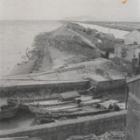Reid, Anthony. “Humans and Forests in Pre-colonial Southeast Asia.” Environment and History 1, no. 1 (Feb., 1995): 93–110. doi:10.3197/096734095779522717. Until about fifteen centuries ago the interaction of humans with the Southeast Asian rainforest was primarily one of interdependence. Trees were felled for food and aromatic woods, and in dryer zones to burn in a process of shifting cultivation, but population pressures were low enough for routine regeneration. Before the modern era of plantation agriculture and mechanized logging, two great changes had already affected the environment profoundly: (1) the elaboration of permanently irrigated rice fields in upland valleys, creating substantial areas of permanent agricultural land progressively from about the eighth century, and making possible greater concentrations of population, both agricultural and urban; and (2) the rapid growth of commercial agriculture from the fifteenth century, primarily in pepper but later also sugar, cloves, gambier, and coffee, which permanently deforested large areas of Sumatra, Java, Borneo, Vietnam, and the Malayan Peninsula. Parallel with this development was the increased commercial felling of forest trees for the export of sandalwood from Timor and sappanwood from Siam. The retreat of large mammals, notably elephant and rhinoceros, was one measure of these changes. All rights reserved. © 1995 The White Horse Press
"Humans and Forests in Pre-colonial Southeast Asia"
Reid, Anthony | from Multimedia Library Collection:
Environment and History (journal)


